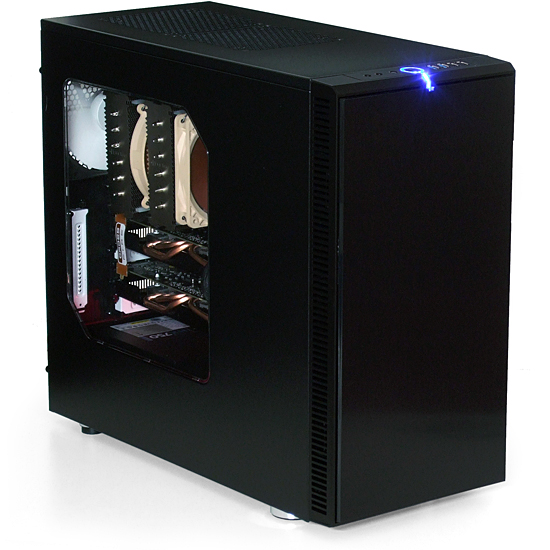System Builder Marathon, Q1 2013: $1,600 Alternative PC
The Magic Of Anticipation
System Builder Marathon, Q1 2013: The Articles
Here are links to each of the four articles in this quarter’s System Builder Marathon (we’ll update them as each story is published). And remember, these systems are all being given away at the end of the marathon.
To enter the giveaway, please fill out this SurveyGizmo form, and be sure to read the complete rules before entering!
Day 1: The $600 Gaming PC
Day 2: The $800 Enthusiast PC
Day 3: The $1,000 Performance PC
Day 4: Performance And Value, Dissected
Day 5: The $1,600 Alternative PC
Introduction
Surprise! You thought our System Builder Marathon ended last week, right? Well, we were busy working on one final follow-up that doubles the price of Don's $800 machine to see if the limitations of this quarter's narrow price band can be overcome at a still-reasonable $1,600.
Most of Tom's Hardware's editors were enthusiasts before they ever dreamed about covering technology in print. We read dozens of competing review sites to gather the most unbiased balance of opinion and test results before finally plopping down our hard-earned dollars on a handful of parts.
Now, a lot of the components we write about show up at our offices before they're even available to everyone else, and sometimes that pile of free stuff pulls us away from the realities of saving up over the course of weeks or months for a value-packed system to replace once-modern technology. Fortunately, regular interaction with our audience helps keep us grounded.
We continue building our own boxes and participating in the comments for each of the stories we write. Because of this, we're pretty good about anticipating the responses we're going to get for each of our System Builder Marathon machines. Although we're not prophets, we have a pretty good bead on the ways of the enthusiasts. We knew that tightly framing this quarter's competition around the expected price/performance pinnacle would leave a lot of you searching for something more.
That anticipation compelled us to order the parts for an upgraded version of our $1,000 PC for a fifth-day bonus build more than a month ago, priced at $1,600.
But wait. We've been sitting on the parts for a month. The Marathon was published last week. What took us so long to get this story done? What did I fail to anticipate? Today's piece is loaded with twists and turns. Grab a cup of coffee or tea, and join us as we put this last System Builder Marathon machine together.
| Q1 2013 $1,600 Alternative PC Components | ||
|---|---|---|
| Processor | Intel Core i5-3570K: 3.4 GHz Base Clock Rate. 3.8 GHz Turbo Boost, Quad-Core, 6 MB Shared L3 Cache | $230 |
| Graphics | 2 x PowerColor PCS+ AX7870 Myst Edition 2GBD5-2DHPPV3E | $520 |
| Motherboard | Gigabyte Z77X-UD4H: LGA 1155, Intel Z77 Express | $170 |
| Memory | Crucial Ballistix Tactical BLT2K4G3D1608ET3LX0: DDR3-1600 C8, 8 GB (2 x 4 GB) | $48 |
| System Drive | Mushkin MKNSSDCR240GB-DX: 240 GB, SATA 6Gb/s SSD | $180 |
| Storage Drive | Western Digital WD1002FAEX: 1 TB, SATA 6Gb/s Hard Drive | $105 |
| Optical | Asus DRW-24B1ST: 24x DVD±R, 12x DVD±R DL | $20 |
| Case | Fractal Design Define R4 w/Window | $120 |
| Power | Corsair HX750: 750 W Modular, ATX12V v2.3, 80 PLUS Gold | $120 |
| CPU Cooler | Noctua NH-D14 | $81 |
| Row 10 - Cell 0 | Total Cost | $1,594 |
The prices in that table were what we paid when the parts were ordered, and a lot of them changed over the last six weeks. For example, the PowerColor card is $20 less, per board. Other prices are up. All told, then, the total cost of buying our machine and replicating the build is within $20 of our original invoice.
Get Tom's Hardware's best news and in-depth reviews, straight to your inbox.
-
Crashman Azn CrackerAren't the 7870 myst only $240 a piece?See This?Reply
Article TextThe prices in that table were what we paid when the parts were ordered, and a lot of them changed over the last six weeks. For example, the PowerColor card is $20 less, per board. Other prices are up. All told, then, the total cost of buying our machine and replicating the build is within $20 of our original invoice. -
mikenygmail Please call the graphics cards 7870 LE from the start, like this:Reply
"Video Cards: 2 x 7870 LE - PowerColor PCS+ AX7870 Myst Edition"
After all, it is much more than a standard 7870.
I had no idea it was the LE until I got to the third page. -
Crashman mikenygmailPlease call the graphics cards 7870 LE from the start, like this:"Video Cards: 2 x 7870 LE - PowerColor PCS+ AX7870 Myst Edition"After all, it is much more than a standard 7870.I had no idea it was the LE until I got to the third page.In AMD/ATI model lingo, LE stands for a cut-down part. So a Tahiti-LE wouldn't be a 7870 LE, it would be a 7950 LE. The fact that it carries the 7870 model number is unfortunate, but the article attempts to make it clear that this is indeed a Tahiti-LEReply
-
Crashman StickmansamWhy not the 7870XT like Sapphire calls it?That's fine, please tell AMD to do the re-brand!Reply -
pyro226 "a board damaged a processor that in turn damaged every board it touched, which in turn would damage every processor it touched" and ram damaging a CPU?Reply
I think I'm a bit afraid to build computers now. If either of those situations would have happened to my $600 build, I would have cried and given up... -
Fulgurant pyro226"a board damaged a processor that in turn damaged every board it touched, which in turn would damage every processor it touched" and ram damaging a CPU?I think I'm a bit afraid to build computers now. If either of those situations would have happened to my $600 build, I would have cried and given up...Reply
That sort of thing happens once in a blue moon. Don't let it bother you.
I guess Tom's tale of woe summarizes why Intel recommends against higher than 1.575 volts on the memory controller of Ivy/Sandy:
http://www.intel.com/support/processors/sb/CS-029913.htm#4
IntelWhat are the Intel® Core™ i7 desktop processor DDR3 memory voltage limitations?Intel® recommends using memory that adheres to the Jedec memory specification for DDR3 memory which is 1.5 volts, plus or minus 5%. Anything more than this voltage can damage the processor or significantly reduce the processor life span.
In any case, the performance benefits of overclocking memory on a Sandy/Ivy platform seem so miniscule that it's scarcely even worth considering. Buy memory capable of an appropriate speed @ 1.5V, and leave it be.
(I know Tom mentions Intel's position on memory voltage on the last page of the article, but I wanted to re-emphasize it because I've seen literally hundreds of people dismiss Intel's statement on various hardware forums. When sites like Tom's Hardware push limits, even for questionable performance gains, we all benefit -- but when someone who's on a budget and might not know any better pushes limits on his own, hard-earned hardware, the results might be tragic. Tom's experiments with this stuff so we don't have to.) -
Crashman pyro226"a board damaged a processor that in turn damaged every board it touched, which in turn would damage every processor it touched" and ram damaging a CPU?I think I'm a bit afraid to build computers now. If either of those situations would have happened to my $600 build, I would have cried and given up...I told Chris the system was cursed, but he refused to let the project go after the seventh day. Three more days rescued the content, if not the hardware...Reply
FulgurantThat sort of thing happens once in a blue moon. Don't let it bother you.Once every 12 years is twice in 13 years too often...


